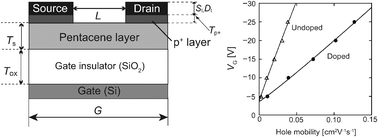Experimental and numerical investigation of contact-area-limited doping for top-contact pentacene thin-film transistors with Schottky contact
Abstract
Effects of contact-area-limited doping for pentacene thin-film transistors with a bottom-gate, top-contact configuration were investigated. The increase in the drain current and the effective field-effect mobility was achieved by preparing hole-doped layers underneath the gold contact electrodes by coevaporation of pentacene and 2,3,5,6-tetrafluoro-7,7,8,8-tetracyanoquinodimethane (F4TCNQ), confirmed by using a thin-film organic transistor advanced simulator (TOTAS) incorporating Schottky contact with a thermionic field emission (TFE) model. Although the simulated electrical characteristics fit the experimental results well only in the linear regime of the transistor operation, the barrier height for hole injection and the gate-voltage-dependent hole mobility in the pentacene transistors were evaluated with the aid of the device simulation. This experimental data analysis with the simulation indicates that the highly-doped semiconducting layers prepared in the contact regions can enhance the charge carrier injection into the active semiconductor layer and concurrent trap filling in the transistor channel, caused by the mitigation of a Schottky energy barrier. This study suggests that both the contact-area-limited doping and the device simulation dealing with Schottky contact are indispensable in designing and developing high-performance organic thin-film transistors.

- This article is part of the themed collection: Organic Field Effect Transistors

 Please wait while we load your content...
Please wait while we load your content...